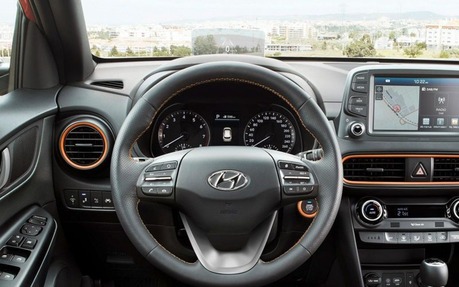Here’s how the 2018 Hyundai Kona Beats BMW and Lexus
Keep your head up! That’s the best way to enjoy one of the Kona’s most advanced features.
Head-up display (HUD) is a technology initially developed for the aviation sector that progressively migrated to the car industry. First popularized by General Motors in the late 1990s, then by exotic brands such as BMW and Lexus, it is now widely available in more affordable vehicles.
- Also: 2018 Hyundai Kona: Among the Best
- Also: 2019 Hyundai Santa Fe Barely More Expensive Despite Full Redesign
Mazda, Toyota, Chevrolet… and now, Hyundai, which takes the lead, the HUD in its all-new Kona subcompact SUV being the largest one on the market, according to the manufacturer.
Is it really useful? Or is it one of those needless gadgets the Korean brands are particularly fond of?
Soft on the eye
Head-up displays send an image in front of the driver’s eyes by bumping a light source off the vehicle’s windshield, which is at an ideal angle to properly reflect an image originating from the farthest part of the dashboard. Like Mazda, however, Hyundai opted for a separate deflector located nearer to the steering wheel.
It can show the vehicle’s speed and information coming from the multimedia system, as well as driving directions. Speaking of which, the Kona has one of the simplest and best multimedia interfaces in the market. The touchscreen display is uncluttered, and is framed by a series of physical buttons that take the user straight to where he or she wants to go in the menus and options.
It also displays whatever essential info it can provide on the HUD, so the driver can be aware of it without taking his or her eyes off the road ahead.
Full-size display
Hyundai describes its system as a “form of augmented reality showing information so that it appears in the driver’s field of view.”
To be exact, it’s been designed to create an eight-inch (virtual) display, at a distance of two metres from the driver’s eyes. As such, it’s the largest in the industry. It’s also the brightest, at 10,000 candelas (a light intensity unit).
On top of speed and driving directions, it can also display the info on the music being played by the audio system, the level of fuel left in the tank, and alerts coming from the lane departure and blind spot monitoring systems.
Did you say augmented reality?
Yes, and prepare to read and hear these words more and more, since these head-up displays currently on the market are only the beginning of a larger trend toward enhanced virtual displays occupying as much of the windshield as it will be allowed to, limited only by the technology itself, or the willingness of manufacturers to market such a technology.
By combining data gathered by the vehicle’s various sensors (lidars, radars, cameras…) with those displays, the on-board computer will eventually be able to highlight the highway lane or exit you need to take to get to destination, to show the exact distance between you and the vehicles ahead, and other complex pieces of information that will make driving safer and more efficient.
It’s not Hyundai who says that, it’s big OEMs such as Bosch and Continental, who are working on those exact systems right now.
So, heads-up, folks: to get a taste of what AR will be like in the near future, take a look at today’s in-car HUD systems, they’ll give you an idea of what’s next…
